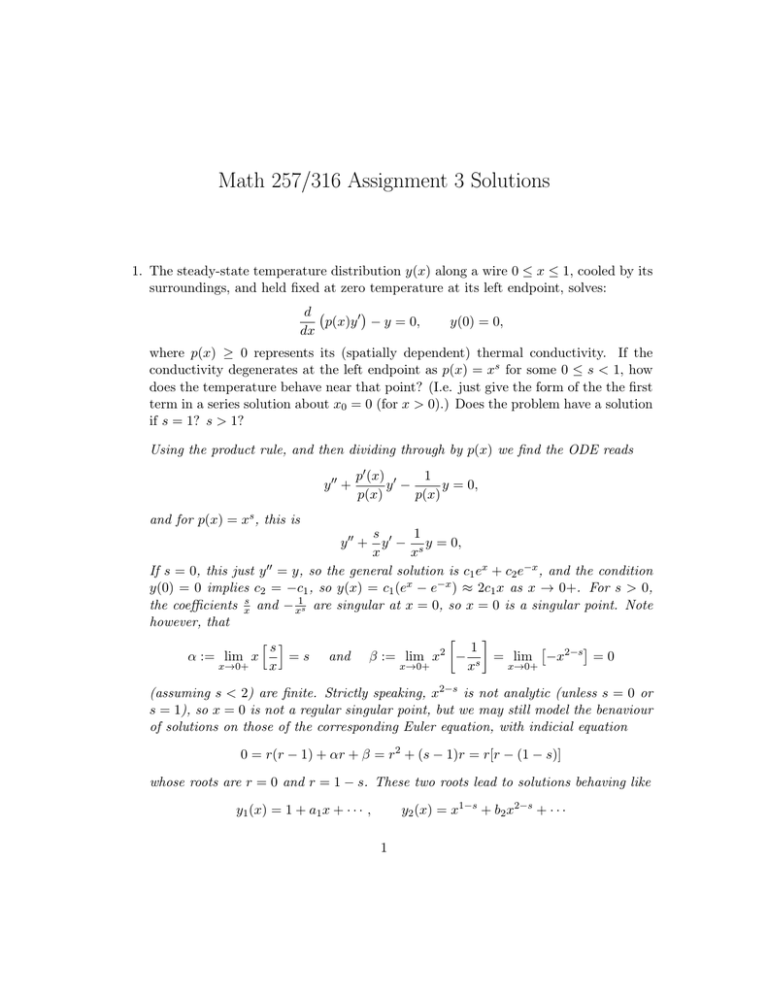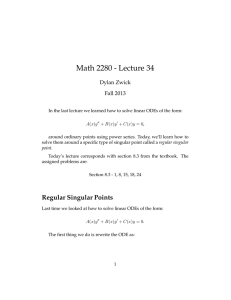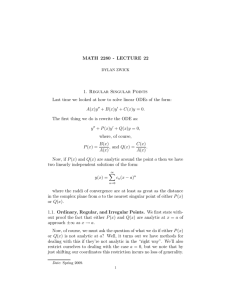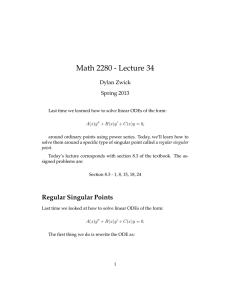Math 257/316 Assignment 3 Solutions
advertisement

Math 257/316 Assignment 3 Solutions 1. The steady-state temperature distribution y(x) along a wire 0 ≤ x ≤ 1, cooled by its surroundings, and held fixed at zero temperature at its left endpoint, solves: d p(x)y 0 − y = 0, dx y(0) = 0, where p(x) ≥ 0 represents its (spatially dependent) thermal conductivity. If the conductivity degenerates at the left endpoint as p(x) = xs for some 0 ≤ s < 1, how does the temperature behave near that point? (I.e. just give the form of the the first term in a series solution about x0 = 0 (for x > 0).) Does the problem have a solution if s = 1? s > 1? Using the product rule, and then dividing through by p(x) we find the ODE reads y 00 + p0 (x) 0 1 y − y = 0, p(x) p(x) and for p(x) = xs , this is 1 s 0 y − s y = 0, x x If s = 0, this just y 00 = y, so the general solution is c1 ex + c2 e−x , and the condition y(0) = 0 implies c2 = −c1 , so y(x) = c1 (ex − e−x ) ≈ 2c1 x as x → 0+. For s > 0, the coefficients xs and − x1s are singular at x = 0, so x = 0 is a singular point. Note however, that hsi 1 2 α := lim x = s and β := lim x − s = lim −x2−s = 0 x→0+ x→0+ x→0+ x x y 00 + (assuming s < 2) are finite. Strictly speaking, x2−s is not analytic (unless s = 0 or s = 1), so x = 0 is not a regular singular point, but we may still model the benaviour of solutions on those of the corresponding Euler equation, with indicial equation 0 = r(r − 1) + αr + β = r2 + (s − 1)r = r[r − (1 − s)] whose roots are r = 0 and r = 1 − s. These two roots lead to solutions behaving like y2 (x) = x1−s + b2 x2−s + · · · y1 (x) = 1 + a1 x + · · · , 1 as x → 0+, and the general solution is y(x) = ay1 (x)+by2 (x). The condition y(0) = 0 implies a = 0, and so y(x) ≈ bx1−s for x near 0, for some constant b. If s > 1, y2 (x) is unbounded as x → 0+ and so we need a = b = 0 and the only solution is y ≡ 0. Note that if s = 1, the indicial equation has double root r = 0 and we find y1 (x) = 1 + a1 x + · · · , y2 (x) = ln(x) + a1 x ln(x) + b1 x + · · · as x → 0+, and so the only solution y(x) = ay1 (x) + by2 (x) with y(0) = 0 has a = b = 0 and so y ≡ 0. 2. Find (the first three non-zero terms of) a series solution (about x0 = 0) of this initial value problem for a spherical Bessel equation: x2 d2 y dy 5 + 2x + (x2 − )y = 0, 2 dx dx 16 y(0) = 0, lim x3/4 y 0 (x) = 1. x→0+ Dividing through by the lead coefficient reveals y 00 + Since p(x) = x2 and q(x) = 1 − Since, as x → 0, 2 0 5 y + (1 − )y = 0. x 16x2 5 16x2 are singular at x = 0, x = 0 is a singular point. 5 5 → 16 16 are finite, this is a regular singular point. The indicial equation, xp(x) = 2 → 2, x2 q(x) = x2 − 0 = r(r − 1) + 2r + (−5/16) = r2 + r − 5/16 = (r + 5/4)(r − 1/4), has roots r1 = 1/4 and r2 = −5/4. Thus we will find Frobenius series solutions (for x > 0) of the form y2 (x) = x−5/4 + b1 x−1/4 + b2 x3/4 + · · · , y1 (x) = x1/4 + a1 x5/4 + a2 x9/4 + · · · , and the general solution will be y(x) = c1 y1 (x) + c2 y2 (x) = c2 x−5/4 + c2 b1 x−1/4 + c1 x1/4 + c2 b2 x3/4 + c1 a1 x5/4 + · · · . The requirement y(0) = 0 implies that c2 = 0 (other wise y(x) is unbounded as x → 0+ !). The other requirement then implies 5 3/4 0 3/4 1 −3/4 1/4 1 = lim x y (x) = lim x c1 x + c1 a1 x + · · · x→0+ x→0+ 4 4 1 4 1 = lim c1 + c1 a1 x + · = c1 . x→0+ 4 5 4 2 So c1 = 4. Now let’s find the (first few terms of the) series we do not P for y1 (notice n+1/4 (remember, have to bother finding y2 !). As usual, differentiate y = ∞ a x n=0 n we have already chosen r = 1/4) and substitute into our ODE to find 0 = x2 ∞ X ∞ n=0 = ∞ X ∞ ∞ X X 1 7 3 1 1 3 1 5 X (n + )(n − )an xn− 4 + 2x an xr+ 4 (n + )an xn− 4 + x2 an xn+ 4 − 4 4 4 16 n=0 1 1 3 (n + )(n − )an xn+ 4 + 4 4 n=0 ∞ X ∞ X n=0 ∞ X 1 1 2(n + )an xn+ 4 + 4 n=0 n=0 ∞ X 9 an xn+ 4 n=0 ∞ X ∞ X 1 5 − an xr+ 4 16 n=0 ∞ X 1 1 1 1 5 1 1 3 (n + )(n − )an xn+ 4 + 2(n + )an xn+ 4 + an−2 xn+ 4 − an xr+ 4 4 4 4 16 n=0 n=0 n=2 n=0 5 1 3 1 5 1 10 5 a0 x1/4 + a1 x5/4 = − · + − · + − 4 4 2 16 4 5 4 16 ∞ X 1 1 3 1 5 + (n + )(n − ) + 2(n + ) − an + an−2 xn+ 4 4 4 4 16 n=2 ∞ X 1 39 3 1/4 5/4 = [0] a0 x + a1 x + n(n + )an + an−2 xn+ 4 . 16 2 = n=2 Notice that the coefficient of the first term is already zero – that’s because we already chose r = 1/4 to be a root of the indicial equation ! – and so a0 is free. As indicated above, we’ll simply choose a0 = 1. The second term shows us that a1 = 0. And then the recurrence relation is an−2 an = − , n = 2, 3, 4, . . . . n(n + 32 ) So 1 a2 1 a0 =− , a3 = 0, a4 = − = ,..., 7 7 22 7 · 22 1 so y1 (x) = x1/4 − 17 x9/4 + 7·22 x17/4 + · · · , and a2 = − 4 2 y(x) = 4y1 (x) = 4x1/4 − x9/4 + x17/4 + · · · . 7 7 · 11 3. In the notes, one solution of the Bessel equation of order zero x2 y 00 + xy 0 + x2 y = 0 is found to be ∞ X 1 2 1 4 1 (−1)m 2m 6 J0 (x) = 1 − 2 x + 2 2 x − 2 2 2 x + · · · = x . 2 2 4 2 4 6 22m (m!)2 m=0 3 Find a second (linearly independent) solution of the form y2 (x) = J0 (x) ln(x) + ỹ(x) as follows: (a) show that for y2 to solve the Bessel equation, ỹ must solve the ode x2 ỹ 00 + xỹ 0 + x2 ỹ + 2xJ00 (x) = 0; Since y20 = J00 ln(x) + J0 (x) 1 + ỹ 0 , x y200 = J000 ln(x) + 2J00 (x) 1 1 − J0 (x) 2 + ỹ 00 , x x we require 0 = x2 y200 + xy20 + x2 y2 = [x2 J000 + xJ00 + x2 J0 ] ln(x) + x2 ỹ 00 + xỹ 0 + x2 ỹ + 2xJ00 (x), and since J0 itself solves the ODE, the term with the ln(x) disappears, leaving 0 = x2 ỹ 00 + xỹ 0 + x2 ỹ + 2xJ00 (x). (b) find the first three non-zero terms of a series solution ỹ(x) = ode. P∞ n=1 bn x n of this After observing 1 1 1 J00 (x) = − x + 2 x3 − 2 2 x5 + · · · , 2 2 4 2 4 6 as usual, we differentiate the power series and plug in to the ODE to find: ∞ ∞ ∞ X X X 1 1 3 1 2 n−2 n−1 2 n 5 0=x n(n − 1)bn x +x nbn x +x bn x + 2x − x + 2 x − 2 2 x + · · · 2 2 4 2 4 6 n=1 n=1 n=1 ∞ ∞ ∞ X X X 1 1 = n(n − 1)bn xn + nbn xn + bn xn+2 + −x2 + x4 − 6 x4 + · · · 8 2 3 n=1 n=1 n=1 ∞ ∞ ∞ X X X 1 4 1 4 n n n 2 = n(n − 1)bn x + nbn x + bn−2 x + −x + x − 6 x + · · · 8 2 3 n=1 n=1 n=3 1 = b1 x + (4b2 − 1)x2 + (9b3 + b1 )x3 + (16b4 + b2 + )x4 + (25b5 + b3 )x5 8 1 4 + (36b6 + b4 − 6 )x + · · · 2 3 4 and so: b1 = 0, b5 = − 1 b2 = , 4 b3 = 0, 25 b1 1 1 3 = 0, b4 = − (b2 + ) = − 7 , 9 16 8 2 1 1 11 b6 = − (b4 − 6 ) = 9 3 . 36 2 3 2 ·3 b3 = − Thus 1 3 11 ỹ = x2 − 7 x4 + 8 3 x6 + · · · . 4 2 2 ·3 So putting it all together: 1 1 1 3 y2 (x) = J0 (x) ln(x) + ỹ = ln(x) − x2 ln(x) + x2 − 6 x4 ln(x) − 7 x4 + · · · . 4 4 2 2 5








